Microfinance: A Comparative Report on Grameen Bank and South Africa
VerifiedAdded on 2023/01/18
|5
|1150
|91
Report
AI Summary
This report summarizes a presentation on microfinance, exploring its definition, the Grameen Bank's success in Bangladesh, and its failures in South Africa. It details the Grameen Bank's structure, growth, and impact on rural development, including increased women's participation and poverty reduction. The report highlights the bank's core principles and key decisions contributing to its success. Conversely, it examines the negative impacts of microfinance in South Africa, including debt traps and the channeling of resources to unproductive businesses. The report concludes by emphasizing the importance of carefully designed microfinance schemes to replicate the Grameen Bank's successes and avoid the pitfalls observed in South Africa. The report references multiple sources to support its claims.
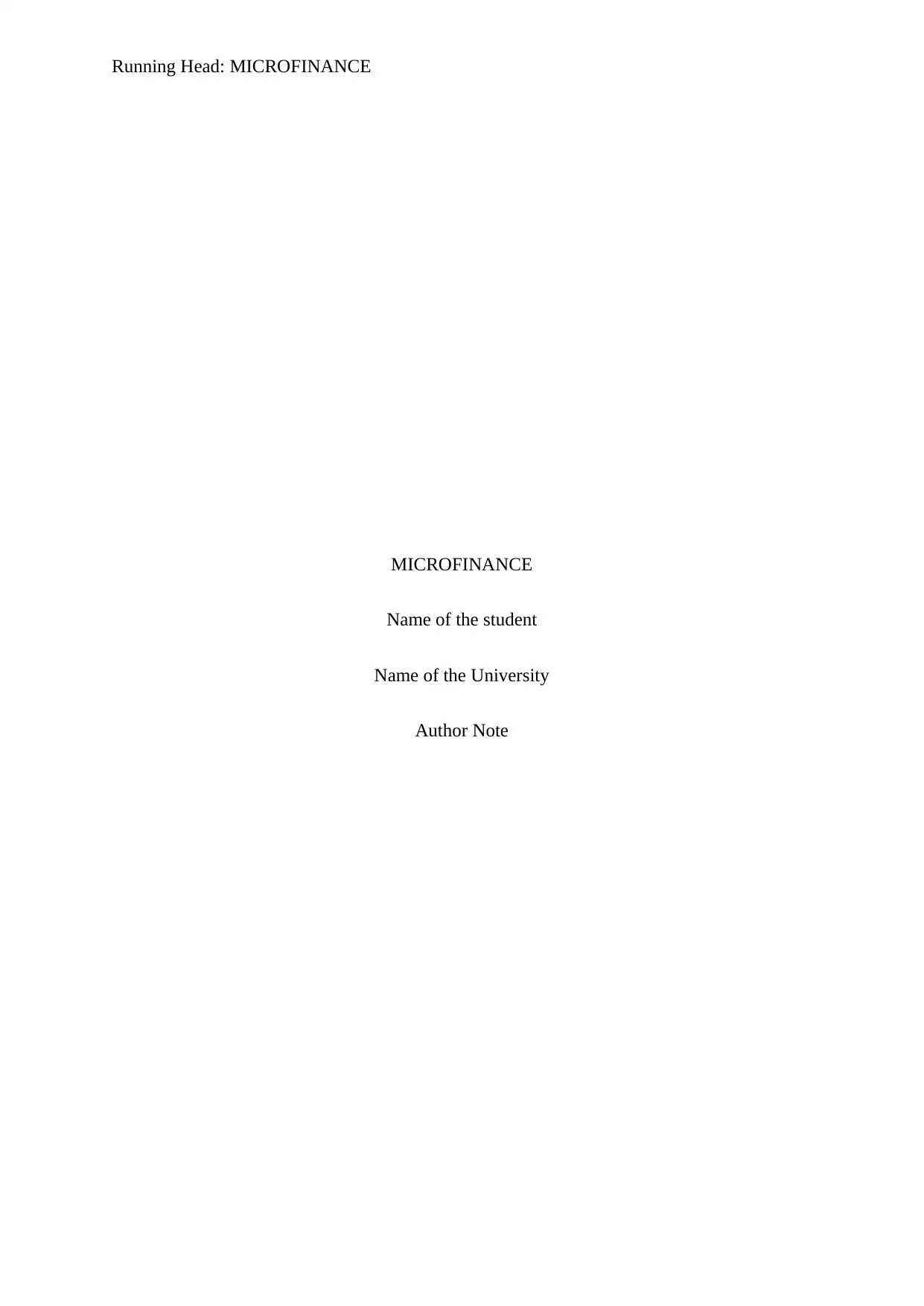
Running Head: MICROFINANCE
MICROFINANCE
Name of the student
Name of the University
Author Note
MICROFINANCE
Name of the student
Name of the University
Author Note
Paraphrase This Document
Need a fresh take? Get an instant paraphrase of this document with our AI Paraphraser
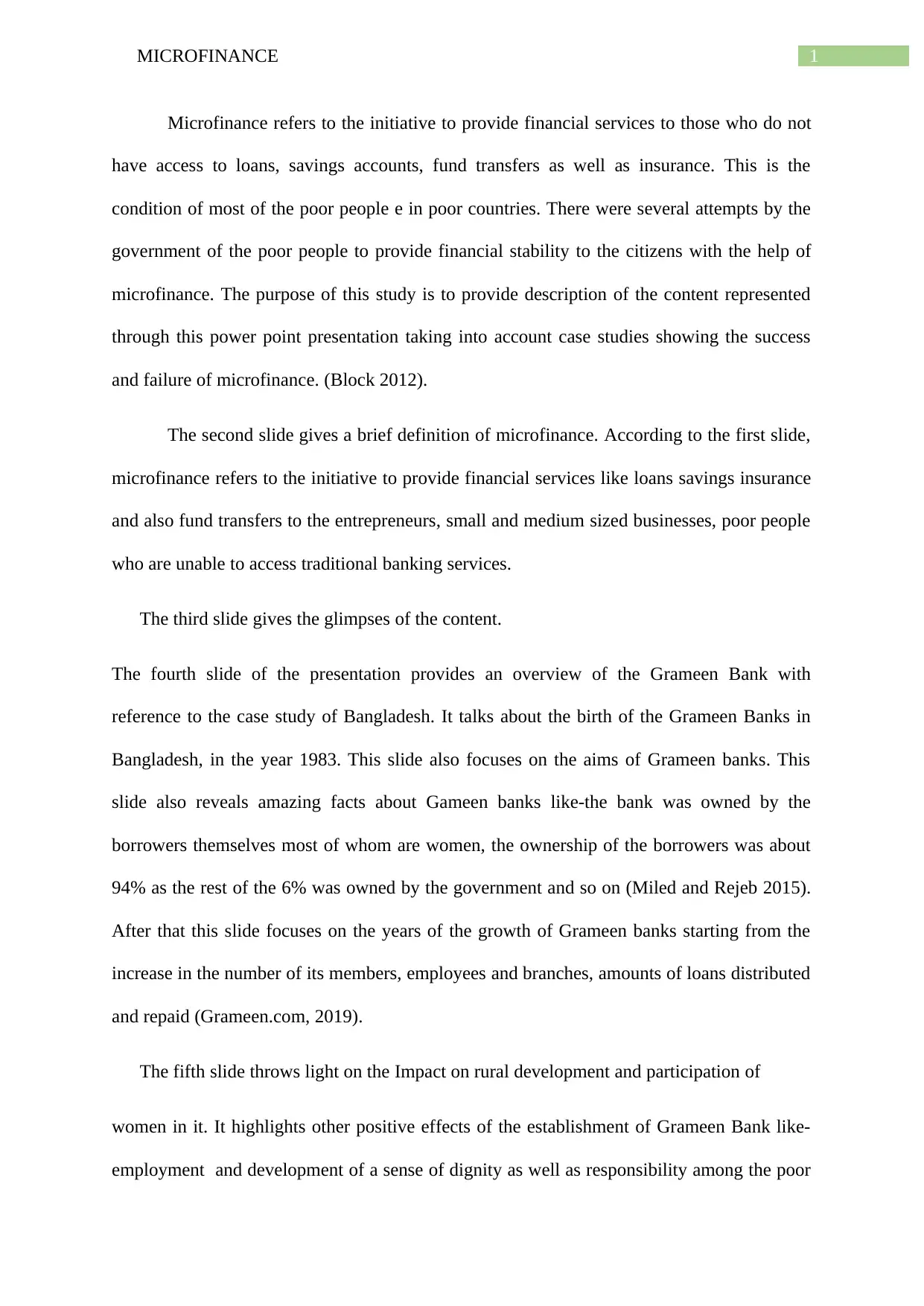
1MICROFINANCE
Microfinance refers to the initiative to provide financial services to those who do not
have access to loans, savings accounts, fund transfers as well as insurance. This is the
condition of most of the poor people e in poor countries. There were several attempts by the
government of the poor people to provide financial stability to the citizens with the help of
microfinance. The purpose of this study is to provide description of the content represented
through this power point presentation taking into account case studies showing the success
and failure of microfinance. (Block 2012).
The second slide gives a brief definition of microfinance. According to the first slide,
microfinance refers to the initiative to provide financial services like loans savings insurance
and also fund transfers to the entrepreneurs, small and medium sized businesses, poor people
who are unable to access traditional banking services.
The third slide gives the glimpses of the content.
The fourth slide of the presentation provides an overview of the Grameen Bank with
reference to the case study of Bangladesh. It talks about the birth of the Grameen Banks in
Bangladesh, in the year 1983. This slide also focuses on the aims of Grameen banks. This
slide also reveals amazing facts about Gameen banks like-the bank was owned by the
borrowers themselves most of whom are women, the ownership of the borrowers was about
94% as the rest of the 6% was owned by the government and so on (Miled and Rejeb 2015).
After that this slide focuses on the years of the growth of Grameen banks starting from the
increase in the number of its members, employees and branches, amounts of loans distributed
and repaid (Grameen.com, 2019).
The fifth slide throws light on the Impact on rural development and participation of
women in it. It highlights other positive effects of the establishment of Grameen Bank like-
employment and development of a sense of dignity as well as responsibility among the poor
Microfinance refers to the initiative to provide financial services to those who do not
have access to loans, savings accounts, fund transfers as well as insurance. This is the
condition of most of the poor people e in poor countries. There were several attempts by the
government of the poor people to provide financial stability to the citizens with the help of
microfinance. The purpose of this study is to provide description of the content represented
through this power point presentation taking into account case studies showing the success
and failure of microfinance. (Block 2012).
The second slide gives a brief definition of microfinance. According to the first slide,
microfinance refers to the initiative to provide financial services like loans savings insurance
and also fund transfers to the entrepreneurs, small and medium sized businesses, poor people
who are unable to access traditional banking services.
The third slide gives the glimpses of the content.
The fourth slide of the presentation provides an overview of the Grameen Bank with
reference to the case study of Bangladesh. It talks about the birth of the Grameen Banks in
Bangladesh, in the year 1983. This slide also focuses on the aims of Grameen banks. This
slide also reveals amazing facts about Gameen banks like-the bank was owned by the
borrowers themselves most of whom are women, the ownership of the borrowers was about
94% as the rest of the 6% was owned by the government and so on (Miled and Rejeb 2015).
After that this slide focuses on the years of the growth of Grameen banks starting from the
increase in the number of its members, employees and branches, amounts of loans distributed
and repaid (Grameen.com, 2019).
The fifth slide throws light on the Impact on rural development and participation of
women in it. It highlights other positive effects of the establishment of Grameen Bank like-
employment and development of a sense of dignity as well as responsibility among the poor
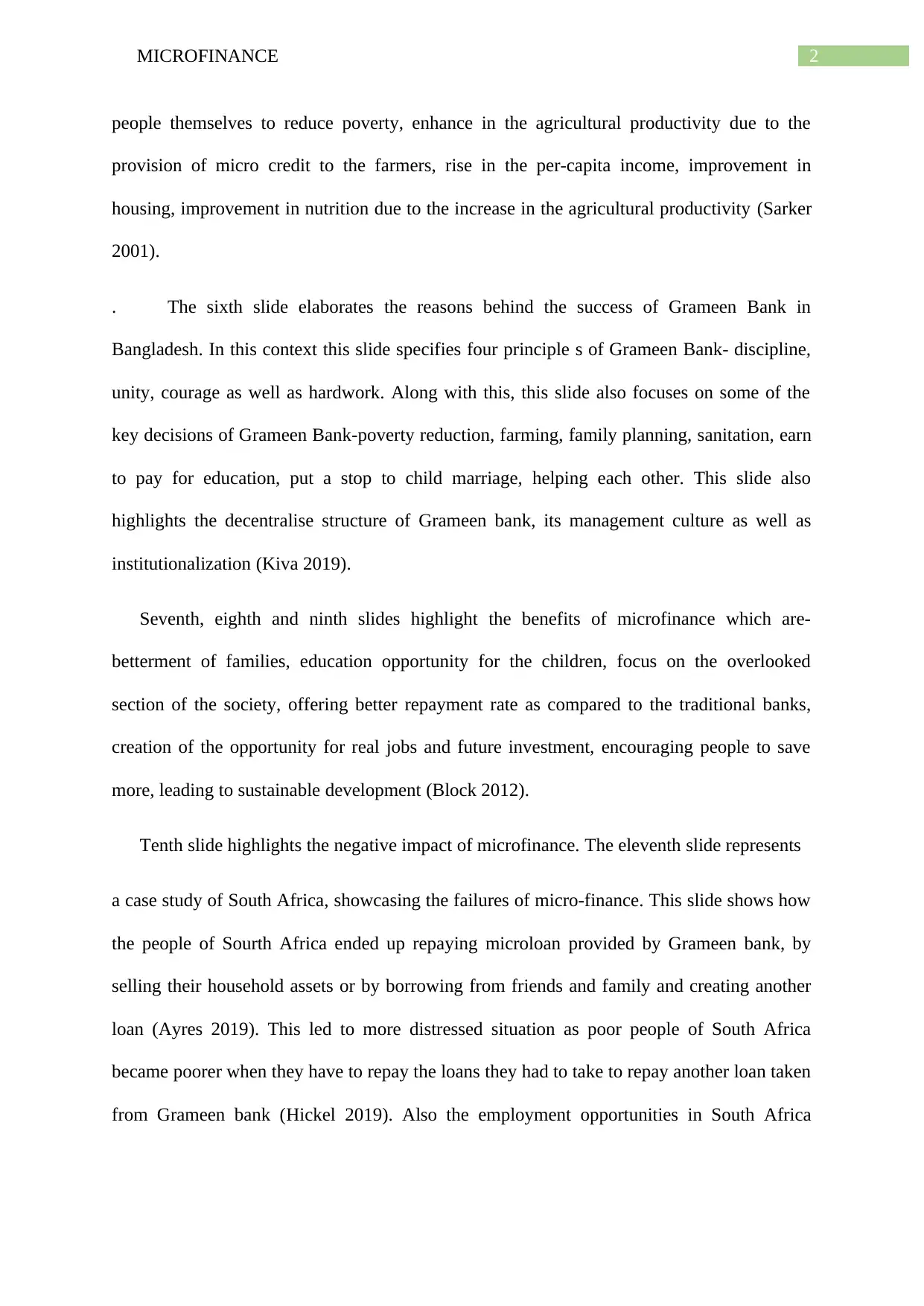
2MICROFINANCE
people themselves to reduce poverty, enhance in the agricultural productivity due to the
provision of micro credit to the farmers, rise in the per-capita income, improvement in
housing, improvement in nutrition due to the increase in the agricultural productivity (Sarker
2001).
. The sixth slide elaborates the reasons behind the success of Grameen Bank in
Bangladesh. In this context this slide specifies four principle s of Grameen Bank- discipline,
unity, courage as well as hardwork. Along with this, this slide also focuses on some of the
key decisions of Grameen Bank-poverty reduction, farming, family planning, sanitation, earn
to pay for education, put a stop to child marriage, helping each other. This slide also
highlights the decentralise structure of Grameen bank, its management culture as well as
institutionalization (Kiva 2019).
Seventh, eighth and ninth slides highlight the benefits of microfinance which are-
betterment of families, education opportunity for the children, focus on the overlooked
section of the society, offering better repayment rate as compared to the traditional banks,
creation of the opportunity for real jobs and future investment, encouraging people to save
more, leading to sustainable development (Block 2012).
Tenth slide highlights the negative impact of microfinance. The eleventh slide represents
a case study of South Africa, showcasing the failures of micro-finance. This slide shows how
the people of Sourth Africa ended up repaying microloan provided by Grameen bank, by
selling their household assets or by borrowing from friends and family and creating another
loan (Ayres 2019). This led to more distressed situation as poor people of South Africa
became poorer when they have to repay the loans they had to take to repay another loan taken
from Grameen bank (Hickel 2019). Also the employment opportunities in South Africa
people themselves to reduce poverty, enhance in the agricultural productivity due to the
provision of micro credit to the farmers, rise in the per-capita income, improvement in
housing, improvement in nutrition due to the increase in the agricultural productivity (Sarker
2001).
. The sixth slide elaborates the reasons behind the success of Grameen Bank in
Bangladesh. In this context this slide specifies four principle s of Grameen Bank- discipline,
unity, courage as well as hardwork. Along with this, this slide also focuses on some of the
key decisions of Grameen Bank-poverty reduction, farming, family planning, sanitation, earn
to pay for education, put a stop to child marriage, helping each other. This slide also
highlights the decentralise structure of Grameen bank, its management culture as well as
institutionalization (Kiva 2019).
Seventh, eighth and ninth slides highlight the benefits of microfinance which are-
betterment of families, education opportunity for the children, focus on the overlooked
section of the society, offering better repayment rate as compared to the traditional banks,
creation of the opportunity for real jobs and future investment, encouraging people to save
more, leading to sustainable development (Block 2012).
Tenth slide highlights the negative impact of microfinance. The eleventh slide represents
a case study of South Africa, showcasing the failures of micro-finance. This slide shows how
the people of Sourth Africa ended up repaying microloan provided by Grameen bank, by
selling their household assets or by borrowing from friends and family and creating another
loan (Ayres 2019). This led to more distressed situation as poor people of South Africa
became poorer when they have to repay the loans they had to take to repay another loan taken
from Grameen bank (Hickel 2019). Also the employment opportunities in South Africa
⊘ This is a preview!⊘
Do you want full access?
Subscribe today to unlock all pages.

Trusted by 1+ million students worldwide
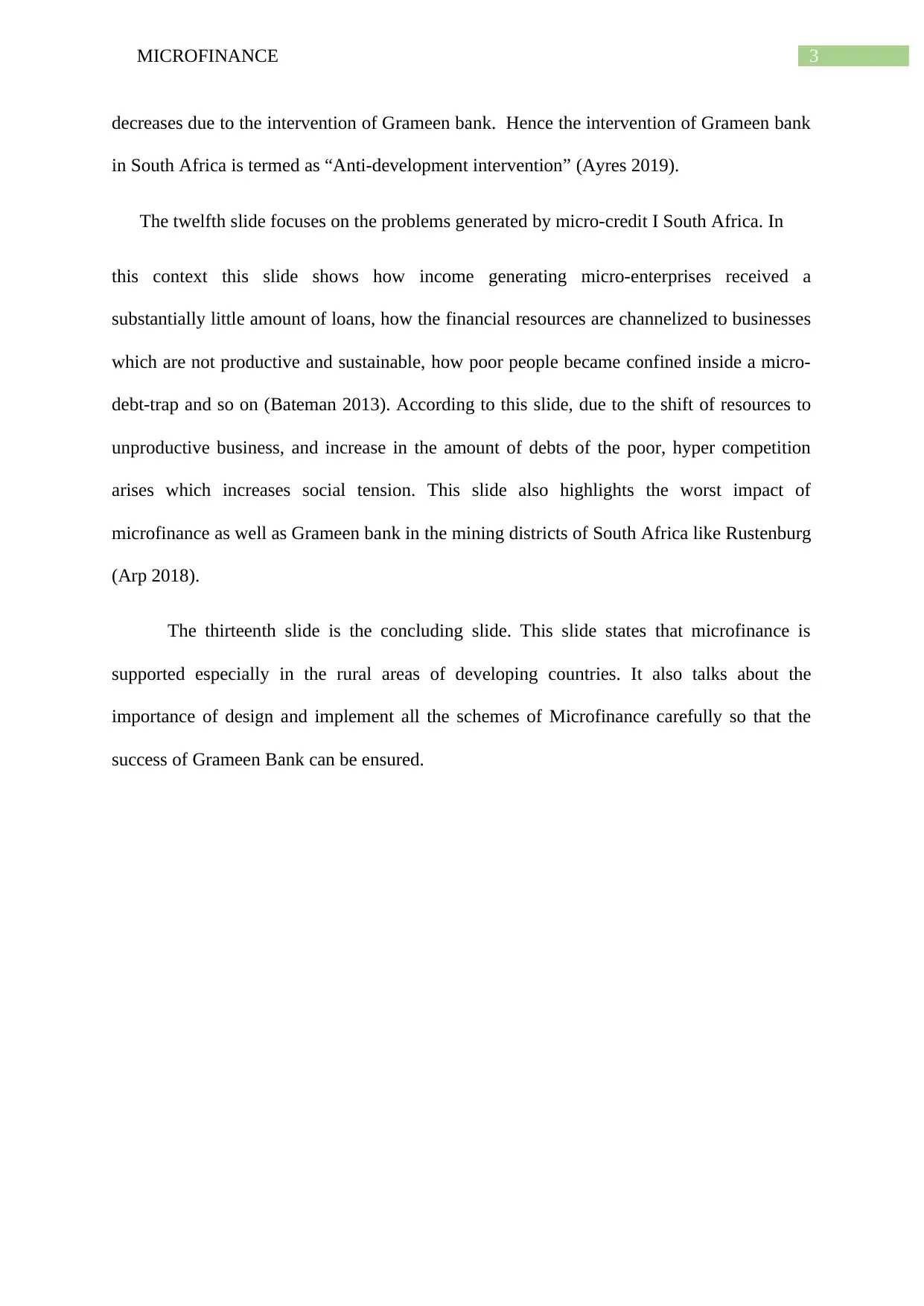
3MICROFINANCE
decreases due to the intervention of Grameen bank. Hence the intervention of Grameen bank
in South Africa is termed as “Anti-development intervention” (Ayres 2019).
The twelfth slide focuses on the problems generated by micro-credit I South Africa. In
this context this slide shows how income generating micro-enterprises received a
substantially little amount of loans, how the financial resources are channelized to businesses
which are not productive and sustainable, how poor people became confined inside a micro-
debt-trap and so on (Bateman 2013). According to this slide, due to the shift of resources to
unproductive business, and increase in the amount of debts of the poor, hyper competition
arises which increases social tension. This slide also highlights the worst impact of
microfinance as well as Grameen bank in the mining districts of South Africa like Rustenburg
(Arp 2018).
The thirteenth slide is the concluding slide. This slide states that microfinance is
supported especially in the rural areas of developing countries. It also talks about the
importance of design and implement all the schemes of Microfinance carefully so that the
success of Grameen Bank can be ensured.
decreases due to the intervention of Grameen bank. Hence the intervention of Grameen bank
in South Africa is termed as “Anti-development intervention” (Ayres 2019).
The twelfth slide focuses on the problems generated by micro-credit I South Africa. In
this context this slide shows how income generating micro-enterprises received a
substantially little amount of loans, how the financial resources are channelized to businesses
which are not productive and sustainable, how poor people became confined inside a micro-
debt-trap and so on (Bateman 2013). According to this slide, due to the shift of resources to
unproductive business, and increase in the amount of debts of the poor, hyper competition
arises which increases social tension. This slide also highlights the worst impact of
microfinance as well as Grameen bank in the mining districts of South Africa like Rustenburg
(Arp 2018).
The thirteenth slide is the concluding slide. This slide states that microfinance is
supported especially in the rural areas of developing countries. It also talks about the
importance of design and implement all the schemes of Microfinance carefully so that the
success of Grameen Bank can be ensured.
Paraphrase This Document
Need a fresh take? Get an instant paraphrase of this document with our AI Paraphraser
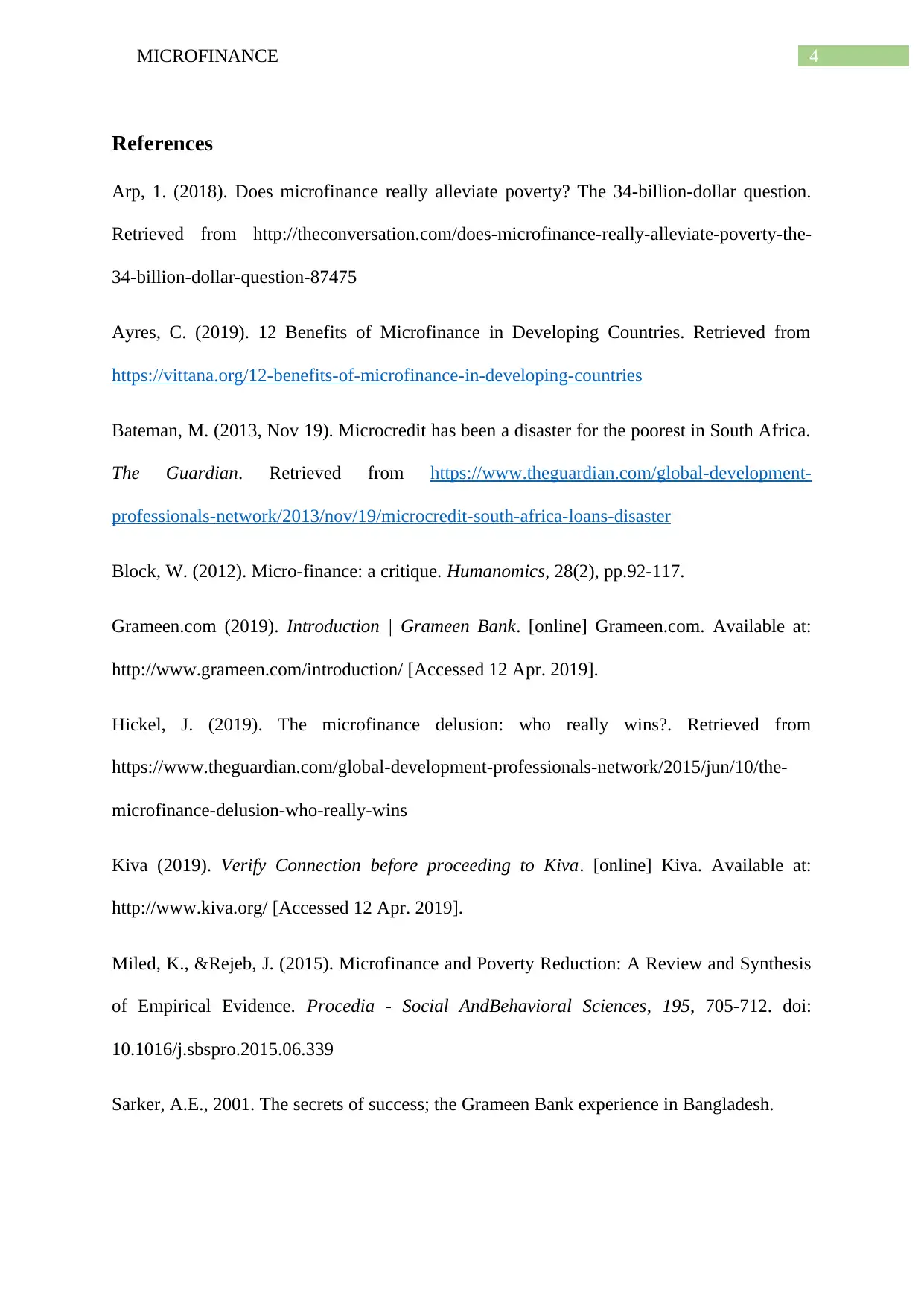
4MICROFINANCE
References
Arp, 1. (2018). Does microfinance really alleviate poverty? The 34-billion-dollar question.
Retrieved from http://theconversation.com/does-microfinance-really-alleviate-poverty-the-
34-billion-dollar-question-87475
Ayres, C. (2019). 12 Benefits of Microfinance in Developing Countries. Retrieved from
https://vittana.org/12-benefits-of-microfinance-in-developing-countries
Bateman, M. (2013, Nov 19). Microcredit has been a disaster for the poorest in South Africa.
The Guardian. Retrieved from https://www.theguardian.com/global-development-
professionals-network/2013/nov/19/microcredit-south-africa-loans-disaster
Block, W. (2012). Micro‐finance: a critique. Humanomics, 28(2), pp.92-117.
Grameen.com (2019). Introduction | Grameen Bank. [online] Grameen.com. Available at:
http://www.grameen.com/introduction/ [Accessed 12 Apr. 2019].
Hickel, J. (2019). The microfinance delusion: who really wins?. Retrieved from
https://www.theguardian.com/global-development-professionals-network/2015/jun/10/the-
microfinance-delusion-who-really-wins
Kiva (2019). Verify Connection before proceeding to Kiva. [online] Kiva. Available at:
http://www.kiva.org/ [Accessed 12 Apr. 2019].
Miled, K., &Rejeb, J. (2015). Microfinance and Poverty Reduction: A Review and Synthesis
of Empirical Evidence. Procedia - Social AndBehavioral Sciences, 195, 705-712. doi:
10.1016/j.sbspro.2015.06.339
Sarker, A.E., 2001. The secrets of success; the Grameen Bank experience in Bangladesh.
References
Arp, 1. (2018). Does microfinance really alleviate poverty? The 34-billion-dollar question.
Retrieved from http://theconversation.com/does-microfinance-really-alleviate-poverty-the-
34-billion-dollar-question-87475
Ayres, C. (2019). 12 Benefits of Microfinance in Developing Countries. Retrieved from
https://vittana.org/12-benefits-of-microfinance-in-developing-countries
Bateman, M. (2013, Nov 19). Microcredit has been a disaster for the poorest in South Africa.
The Guardian. Retrieved from https://www.theguardian.com/global-development-
professionals-network/2013/nov/19/microcredit-south-africa-loans-disaster
Block, W. (2012). Micro‐finance: a critique. Humanomics, 28(2), pp.92-117.
Grameen.com (2019). Introduction | Grameen Bank. [online] Grameen.com. Available at:
http://www.grameen.com/introduction/ [Accessed 12 Apr. 2019].
Hickel, J. (2019). The microfinance delusion: who really wins?. Retrieved from
https://www.theguardian.com/global-development-professionals-network/2015/jun/10/the-
microfinance-delusion-who-really-wins
Kiva (2019). Verify Connection before proceeding to Kiva. [online] Kiva. Available at:
http://www.kiva.org/ [Accessed 12 Apr. 2019].
Miled, K., &Rejeb, J. (2015). Microfinance and Poverty Reduction: A Review and Synthesis
of Empirical Evidence. Procedia - Social AndBehavioral Sciences, 195, 705-712. doi:
10.1016/j.sbspro.2015.06.339
Sarker, A.E., 2001. The secrets of success; the Grameen Bank experience in Bangladesh.
1 out of 5
Related Documents
Your All-in-One AI-Powered Toolkit for Academic Success.
+13062052269
info@desklib.com
Available 24*7 on WhatsApp / Email
![[object Object]](/_next/static/media/star-bottom.7253800d.svg)
Unlock your academic potential
Copyright © 2020–2025 A2Z Services. All Rights Reserved. Developed and managed by ZUCOL.




